- News
- Reviews
- Bikes
- Accessories
- Accessories - misc
- Computer mounts
- Bags
- Bar ends
- Bike bags & cases
- Bottle cages
- Bottles
- Cameras
- Car racks
- Child seats
- Computers
- Glasses
- GPS units
- Helmets
- Lights - front
- Lights - rear
- Lights - sets
- Locks
- Mirrors
- Mudguards
- Racks
- Pumps & CO2 inflators
- Puncture kits
- Reflectives
- Smart watches
- Stands and racks
- Trailers
- Clothing
- Components
- Bar tape & grips
- Bottom brackets
- Brake & gear cables
- Brake & STI levers
- Brake pads & spares
- Brakes
- Cassettes & freewheels
- Chains
- Chainsets & chainrings
- Derailleurs - front
- Derailleurs - rear
- Forks
- Gear levers & shifters
- Groupsets
- Handlebars & extensions
- Headsets
- Hubs
- Inner tubes
- Pedals
- Quick releases & skewers
- Saddles
- Seatposts
- Stems
- Wheels
- Tyres
- Health, fitness and nutrition
- Tools and workshop
- Miscellaneous
- Tubeless valves
- Buyers Guides
- Features
- Forum
- Recommends
- Podcast
review
£4,500.00
VERDICT:
A nicely balanced, quick-handling gravel race bike that is up there with the best, but the price is hard to swallow
Weight:
9,170g
Contact:
At road.cc every product is thoroughly tested for as long as it takes to get a proper insight into how well it works. Our reviewers are experienced cyclists that we trust to be objective. While we strive to ensure that opinions expressed are backed up by facts, reviews are by their nature an informed opinion, not a definitive verdict. We don't intentionally try to break anything (except locks) but we do try to look for weak points in any design. The overall score is not just an average of the other scores: it reflects both a product's function and value – with value determined by how a product compares with items of similar spec, quality, and price.
What the road.cc scores meanGood scores are more common than bad, because fortunately good products are more common than bad.
- Exceptional
- Excellent
- Very Good
- Good
- Quite good
- Average
- Not so good
- Poor
- Bad
- Appalling
Pinarello isn't aiming for the bikepacking adventure market with its new Grevil. The stiff frame with its aerodynamic tube sections and large ratio gearing are aimed purely at maximum velocity, making it a surprisingly fast gravel-bashing speed machine. There are compromises, though, and I'm not just talking about the price.
- Pros: Confident handling on the rough stuff; excellent power transfer
- Cons: Pricey against the opposition; stiff rear end can be skittish; budget wheels
Not everyone wants to carry baggage when they go for a ride, or spend days away from home sleeping in a ditch, but this is the type of thing most gravel/adventure bikes are designed to turn their hand to. The Grevil is designed for just getting out there and smashing it about off the beaten track, and that's something it does very well indeed.
Ride
With a lot of design cues from Pinarello's top end road bikes, and the reasonably low front end for a gravel bike, the Grevil delivers bags of fun when it is being ridden hard.
On loose gravel tracks with the practically slick tyres scrabbling for grip, the feedback through the frame and fork allows you to just get on with the job of powering forward. Shifting your bodyweight and making tiny tweaks to the steering is all it takes to keep the bike just on the edge for maximum grins.
The steering is edging towards quick on the rough surfaces, which makes for some fun moments as you tackle more challenging terrain, but I never found the Pinarello to be overly twitchy.
On the wide, flowing gravel byways that I spend a lot of my time on, you can achieve some impressive speeds, with the odd descent seeing 45-50mph possible.
With the surface pretty much hardpacked you can let the bike go a bit without issue, although the whole trail can be strewn with random large stones and potholes, not to mention the odd part of the top layer being covered in sections of loose gravel. Travelling at speed on that type of terrain, all these little challenges are rushing at you in a blur of dust and vibration, but thanks to the reasonably light weight and overall flickability of the Grevil you can change line or bunny hop in an instant.
When it comes to climbing the Grevil doesn't disappoint either, thanks mainly to the huge size of that bottom bracket junction and thick chainstays for exploiting as much of the power you are putting out as possible. Getting out of the saddle sees the Grevil just get on with the job of propelling you uphill without the slightest whiff of flex.
The downside to this stiffness is that over rough terrain at speed, the rear end of the bike can get bounced around quite a lot, leaving the back wheel feeling a little flighty as it spends just as much time off the ground as it does on it.
It hampers comfort a bit, too, with the Pinarello really calling out for a flexible seatpost like the S15 VCLS found on Canyon's carbon fibre Grail CF SL 8.0 SL to take the sting out of the trail.
Thankfully, up front there are no such issues, which I was surprised about when looking at the chunky profile of the head tube and fork legs. I wouldn't say it is plush, but considering how narrow the handlebar and tape is, I had no issues with pain or fatigue through my hands or wrists, and I don't tend to wear gloves either, even off-road.
> Cyclo-cross vs adventure/gravel bikes: what's the difference?
It's not just off-road that the Grevil performs, though, it's also pretty decent on smoother tarmac. Swapping out the 650B wheels and 47mm tyres for a set of carbon fibre 700Cs and 28mm slicks sees the Pinarello become a great cruiser, a slightly more relaxed Prince FX, if you like – after all, they share a lot of the same design cues.
The handling isn't quite as sharp on the Grevil once it ventures onto the tarmac, but on the whole it feels just like a quick endurance road machine thanks to the quite racy position.
Frame and fork
It's got to be said that the Grevil's frame design really divides opinion when it comes to the shape of the tubes, but I quite like it, especially in this colourway.
Like I said up top, the Grevil takes much of its shape from the Prince and Dogma road models. Things like the profiled head tube and that quirky down tube, which is designed to improve airflow over your water bottle and cage. I'm not sure how much it helps if you make use of the spare pair of bosses underneath the tube, mind.
The Onda fork isn't immune to efforts to smooth the air either, with its comically named Fork Flap, an extended part of the fork leg at the dropout designed to deflect airflow around the disc calliper.
On the whole, I know the Grevil is about being a fast gravel racer, but I can't help thinking, why? Being on the gravel isn't really like slapping out the miles at speed like on the road, where aero tweaks do make a minimal difference, so I don't really see much need for all of this wind-cheating design.
In the relatively short time that gravel bikes have been around we've seen tyre clearance increasing by a fair margin, and with the adoption of smaller 650B wheels there are even more options. If you are running 700C wheels on the Pinarello you can go up to a max of 42mm, which isn't too bad – for the type of riding I do I'm happy with 38mm to 40mm tyres. With the standard 650B wheels attached, you can go up to 2.1in, around 53mm in width.
To accommodate these tyre clearances you can see that Pinarello has dropped the drive side chainstay to provide clearance between the wheels and the crankset.
It's good to see the Grevil getting a threaded bottom bracket on a bike that is going to be spending plenty of time in dusty and muddy conditions, but some will be a little perturbed to see the threading for the cups is of the Italian persuasion.
Where the cups of a BSA threaded bottom bracket have opposite thread directions for the drive and non-drive sides to stop them coming undone through the pedalling action, the Italian options both follow the old righty-tighty, lefty loosey school of thought. Some people have had issues with the cups loosening, but in years of riding a steel frame with the same setup I've never had an issue.
The frame itself is made from Toray T700 carbon fibre, which sits at the upper end of the manufacturer's range of composites. The frame needs to be stiff yet comfortable, plus being carbon fibre it also needs to stand up to some abuse, especially with its off-road intentions, and it looks as though Pinarello has found this grade to offer the best balance of properties.
As you'd expect, the Grevil has full internal routing for the cables and hoses on both the frame and the fork, which works with both mechanical and electronic groupsets.
Front and rear, the brake callipers are attached via flat mounts and there are 12mm thru-axles at each end too.
Overall, it's a nicely finished frame and the paint is pretty hardwearing everywhere – except for the seatpost. Moving it up and down in the frame to get my fit spot on has left a few scratches.
Geometry
The Grevil is available in six sizes, with effective top tube lengths of 510mm through to 600mm. Our test model with a 535mm top tube has a reach of 368mm and a stack of 537mm, which is in race territory for a bike of this ilk, helped mostly by the short 135mm head tube length.
Slamming the stem you can quite a low-slung position on it for powering along on the flatter sections, which I like.
The geometry isn't that steep for a bike designed for speed, with a head angle of just 70.5 degrees (it increases by half a degree on each size) and a seat angle of 73 degrees. It works, though; as I've already said, the Grevil never feels sedate in its handling.
Groupset and finishing kit
This model gets a full Shimano Ultegra R8000 hydraulic groupset, and as you'll see if you read that review, it can't really be faulted.
The only slight difference here compared to the usual road setup is that the Grevil gets an Ultegra RX800 rear derailleur, which includes a clutch to keep the chain tension high to stop flapping when you're hammering over rough surfaces.
I've never had a chain unship using the standard R8000 mech off-road, but the RX800 version does keep the noise down and will protect your chainstay from the bouncing chain.
All of us here at road.cc have our favourite gearing setups for gravel riding, and while some are big fans of the 1x system I'll take a double ringed chainset any day of the week – it just suits the way I ride and is ideal for the type of terrain most of my training and testing takes place on.
While some brands are using smaller rings on their double setups, I think for the race intentions of the Grevil a 50/34 is the right choice, paired to the 11-32 tooth cassette. I had all of the gears I needed for every eventuality. If, however, you are likely to deck out the Grevil with frame and bar bags, adding weight, or live in a hilly area, then a 1x option might well be better for you, with a wide ranging cassette giving you lower gear options.
> How to get ultra-lower gearing for gravel bike adventures
Shimano's hydraulic brakes are brilliant – really progressive and offer loads of power. Pinarello has gone for 160mm diameter rotors front and rear and I'd say that is bang on. On the road 140mm is the norm, but with the unpredictable terrain off road and the fact that some of the descents can be steep and technical, having the larger rotors gives extra peace of mind.
The rest of the finishing kit comes from Pinarello's in-house Most brand.
The handlebar is alloy, and although on a road bike for this sort of money I'd be expecting carbon, I'm quite happy with aluminium for off-road riding, especially once the inevitable crash occurs.
The bar itself has a very small diameter either side of the clamping area, so should you not get on with the rather minimalist Most tape you can swap it for something better padded without making the grip size overly fat.
There is a slight flare to the drops, but I'd like something a little wider like the 12-degree flare found on the Genetic Drove.
The stem is also alloy and does a fine job, plus you get the added aero benefit of the tail end of it with accompanying spacers.
I got on quite well with the saddle, too, liking its stubby shape with a profile that is quite similar to one of my favourites, the Prologo Dimension Nack. The padding is pretty firm but it is definitely supportive, and its short length means you can get down in the drops without crushing anything.
Wheels and tyres
A lot of brands spec cheaper wheels on their bikes to keep costs down, but not usually as markedly as those provided by Pinarello.
The 650B version of the Fulcrum Racing 7 DB isn't a bad wheelset, to be fair. It's a little weighty at around 1,800g but the wheels are solid performers and took ever knock and clatter that came their way on the trails. The Grevil is screaming out for something better, though.
For this kind of money I'd be expecting more, like Fulcrum's Racing 3 DBs. Okay, you won't drop a huge amount of weight, but they have a much nicer ride quality to them.
I tested the Vittoria Terreno Zero G20 tyres a few months back and found them to be quick rolling and grippy, especially on the road.
Having very little tread means they are okay on hardpacked tracks and trails, but if the surface is loose you are left with a bike that will slide all over the place. Fun, yes, but not very constructive when it comes to forward motion.
They are robust enough and still look in pretty good nick, although I did pick up one puncture from a pretty hefty thorn. They're tubeless ready, but Pinarello hasn't set them up that way, sticking with inner tubes.
Value
Brands like Pinarello command a high price thanks to their heritage, fashion and, in recent years, wins of the major tours by riders like Wiggins, Froome and Thomas aboard their bikes, and if you are happy to pay for it then fair play, it's how the world works after all.
There are a lot of options, though, especially if opening up your wallet is driven a little more by your head than your heart.
Canyon's pricing is aggressive, and thanks to its large scale, direct-to-consumer setup many brands struggle to compete, which is why the Grail cannot be dismissed.
The Grail CF SL 8.0 SL I mentioned at the top of this review is literally one of the best bikes I have ever ridden. For a similar build to the Pinarello it's nearly a kilo lighter and just so flickable and precise on the gravel.
> Buyer's Guide: 22 of the best gravel and adventure bikes
I'll admit, though, that the Grevil comes very close to it in terms of handling and ride quality, aside from those stiffness issues I mentioned earlier. Both bikes are about gravel racing rather than adventure, and they both do it very well.
The thing is, the Grail we tested came in at £3,249 against the Grevil's £4,500 – and the Canyon came with carbon wheels.
You can get the non SL version with alloy DT Swiss C 1800 wheels and the cool carbon cockpit plus the flexible seatpost for just £2,349!
It's not just Canyon, either: a similarly specced Wilier Jena Ultegra will set you back £3,399.99, and Mat really liked the frameset.
Conclusion
Take price out of the equation for a minute and against a lot of the other gravel bikes I've ridden the Grevil is very good indeed. I love the way it rides, and the way it looks, and I will be sad to see it go back. But from a consumer point of view, it'd be hard to justify laying out this sort of money on it.
Verdict
A nicely balanced, quick-handling gravel race bike that is up there with the best, but the price is hard to swallow
road.cc test report
Make and model: Pinarello Grevil
Size tested: 53cm
About the bike
List the components used to build up the bike.
From Pinarello:
Carbon Torayca T700 UD
Asymmetric frame
Twin Arms
Flexstays
Dedicated Onda fork
Dedicate aero seat post
Dedicated FSC Frontal seat clamp, integrated and aerodynamic
Think 2, to fit electronical or mechanical groupsets on the same frame
ICR internal cable routing
Drop In bearing system with tapered headset ( 1' 1/8 up; 1' 1/2 down)
Italian thread BB
Flatback profiles
Fork Flap
E-link
Down tube bottle cage
Max Tire: 700c x 42 mm
Max Tire: 650b x 2,1'
1x and 2x crankset option
RAD SYSTEM disc brakes
Disc Flat Mount (max Ø160 mm)
Front Axle Ø12 x 100 mm Shimano®
Rear Axle Ø12 x 142 mm Shimano®
Tell us what the bike is for and who it's aimed at. What do the manufacturers say about it? How does that compare to your own feelings about the bike?
Pinarello says, "Grevil is made to eat the dust, wherever you want to explore, it goes ... fast."
That pretty much sums it up, to be fair.
Where does this model sit in the range? Tell us briefly about the cheaper options and the more expensive options
This is the only model in the range at the moment available as a complete bike; it does come in both 1x and 2x groupset options though.
The Grevil+, which uses a more top end carbon fibre, is available as a frameset only.
Frame and fork
Overall rating for frame and fork
8/10
Tell us about the build quality and finish of the frame and fork?
The Grevil is a quality frameset although I'd say that you need to be careful getting the saddle height right as the paint finish of the seatpost scratches as you move it up and down.
Tell us about the materials used in the frame and fork?
The frame and fork both use Toray T700 UD carbon fibre.
Tell us about the geometry of the frame and fork?
For this type of bike the riding position is quite long and low – you can tell it has race intentions. Full details here.
How was the bike in terms of height and reach? How did it compare to other bikes of the same stated size?
The stack and reach measurements in this size give a ratio of 1.45 which is much more aggressive than I'd expect.
Riding the bike
Was the bike comfortable to ride? Tell us how you felt about the ride quality.
On the whole yes, but it could do with some damping at the rear end.
Did the bike feel stiff in the right places? Did any part of the bike feel too stiff or too flexible?
Everywhere it needs stiffness, it has it.
How did the bike transfer power? Did it feel efficient?
Yes, very efficient mostly thanks to that huge bottom bracket area.
Was there any toe-clip overlap with the front wheel? If so was it a problem?
No.
How would you describe the steering? Was it lively neutral or unresponsive? Just nudging the lively side of neutral.
Tell us some more about the handling. How did the bike feel overall? Did it do particular things well or badly?
You can have a bit of fun with the Grevil. The handling is quick enough that you can quickly get out of shape but there is so much feedback from the frame that you can really feel what the bike is doing beneath you, so you can bring things back under control.
Which components had the most effect (good or bad) on the bike's comfort? would you recommend any changes?
I would like to see a more flexible seatpost than the aero job you get with the Grevil for a more comfortable rear end.
Which components had the most effect (good or bad) on the bike's stiffness? would you recommend any changes?
It's a good all-round package.
Which components had the most effect (good or bad) on the bike's efficiency? would you recommend any changes?
Not everyone will find the gear ratios easy to live with off-road.
Rate the bike for efficiency of power transfer:
9/10
Rate the bike for acceleration:
9/10
Rate the bike for sprinting:
9/10
Rate the bike for high speed stability:
8/10
Rate the bike for cruising speed stability:
8/10
Rate the bike for low speed stability:
8/10
Rate the bike for flat cornering:
8/10
Rate the bike for cornering on descents:
9/10
Rate the bike for climbing:
9/10
The drivetrain
Rate the drivetrain for performance:
9/10
Rate the drivetrain for durability:
8/10
Rate the drivetrain for weight:
8/10
Rate the drivetrain for value:
7/10
Tell us some more about the drivetrain. Anything you particularly did or didn't like? Any components which didn't work well together?
Ultegra works really well as it's hard wearing enough to stand up to the abuse of off-road riding. The RX800 rear mech is a nice touch.
Wheels and tyres
Rate the wheels for performance:
7/10
Rate the wheels for durability:
8/10
Rate the wheels for weight:
7/10
Rate the wheels for comfort:
7/10
Rate the wheels for value:
5/10
Tell us some more about the wheels.Did they work well in the conditions you encountered? Would you change the wheels? If so what for?
Good, solid, dependable wheels but they have no place on a £4.5k bike!
Rate the tyres for performance:
8/10
Rate the tyres for durability:
7/10
Rate the tyres for weight:
7/10
Rate the tyres for comfort:
8/10
Rate the tyres for value:
5/10
Tell us some more about the tyres. Did they work well in the conditions you encountered? Would you change the tyres? If so what for?
Great if you spend a lot of time on the road or hard packed gravel. If the surface is loose, though, you'll need more grip.
Controls
Rate the controls for performance:
8/10
Rate the controls for durability:
7/10
Rate the controls for weight:
7/10
Rate the controls for comfort:
7/10
Rate the controls for value:
5/10
Tell us some more about the controls. Any particularly good or bad components? How would the controls work for larger or smaller riders?
A decent all-round package for the money, although I prefer a bar with a little more flare.
Your summary
Did you enjoy riding the bike? Yes
Would you consider buying the bike? No
Would you recommend the bike to a friend? Yes
How does the price compare to that of similar bikes in the market, including ones recently tested on road.cc?
It's pricey compared to virtually everything else on the market.
Rate the bike overall for performance:
8/10
Rate the bike overall for value:
3/10
Use this box to explain your overall score
It's a really good all-rounder, and if you want to go fast on gravel it is one of the best riding and handling bikes out there, but you really are paying for it.
About the tester
Age: 40
I usually ride: This month's test bike My best bike is: B'Twin Ultra CF draped in the latest bling test components
I've been riding for: Over 20 years I ride: Every day I would class myself as: Expert
I regularly do the following types of riding: time trialling, commuting, club rides, sportives, fixed/singlespeed
Since writing his first bike review for road.cc back in early 2009 senior product reviewer Stu has tested more than a thousand pieces of kit, and hundreds of bikes.
With an HND in mechanical engineering and previous roles as a CNC programmer/machinist, draughtsman and development engineer (working in new product design) Stu understands what it takes to bring a product to market. A mix of that knowledge combined with his love of road and gravel cycling puts him in the ideal position to put the latest kit through its paces.
He first made the switch to road cycling in 1999, primarily for fitness, but it didn’t take long for his competitive side to take over which led to around ten years as a time triallist and some pretty decent results. These days though riding is more about escapism, keeping the weight off and just enjoying the fact that he gets to ride the latest technology as part of his day job.
Latest Comments
- Disgusted of Tunbridge Wells 10 min 34 sec ago
I concur........
- SimoninSpalding 11 min 19 sec ago
BAN CARAVANS!
- Pub bike 13 min 2 sec ago
Panorama used to be a serious programme based on serious journalism informing the public on important issues. What a fall from grace for the BBC.
- Backladder 35 min 59 sec ago
They can be remarkably honest about the consequences of using their vehicles though https://www.youtube.com/watch?v=H8GHiY6jmR8
- Backladder 47 min 5 sec ago
If your old bike is made of steel you can convert to disk, just find an experienced metalworker, give him a mocked up example and ask him to make...
- mdavidford 58 min 13 sec ago
There appears to be a bollard at a 45º angle mostly obscured by the bins - presumably they were able to remove that and then drive through the gap.
- Bigfoz 1 hour 3 min ago
Have to say as a long time and multiple (7 bikes) user of Camapg - I have about half the fleet on genuine rivetted Campag chains and half on SRAM...
- eburtthebike 1 hour 7 min ago
There is also the BBC's own complaints process, which is utterly useless, but it might be good to submit a complaint there to show Ofcom that you...
- Sredlums 1 hour 47 min ago
You don't make it clear what exactly you mean by 'the garments'....





















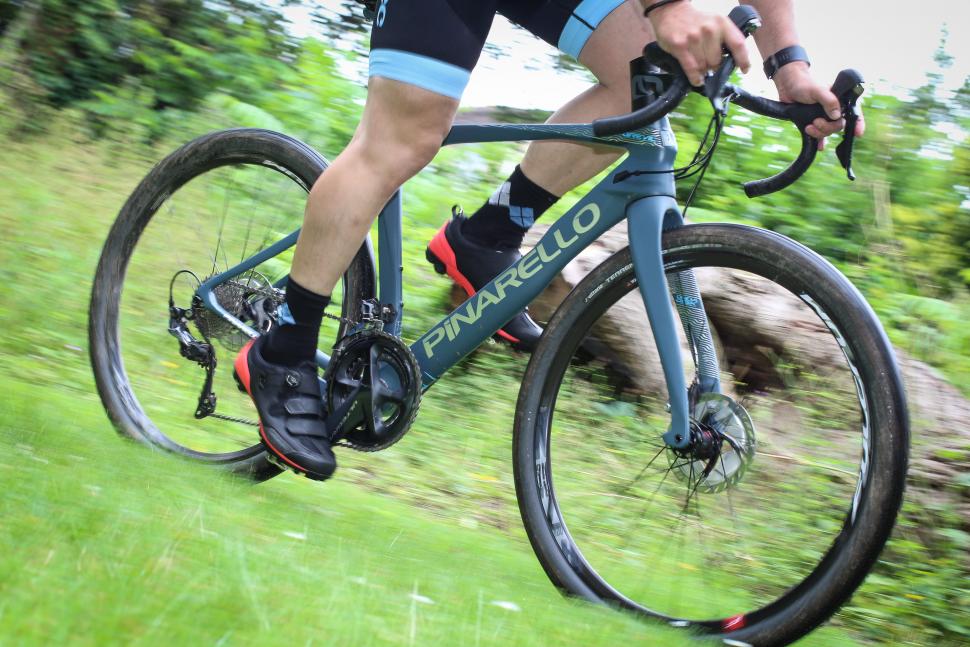

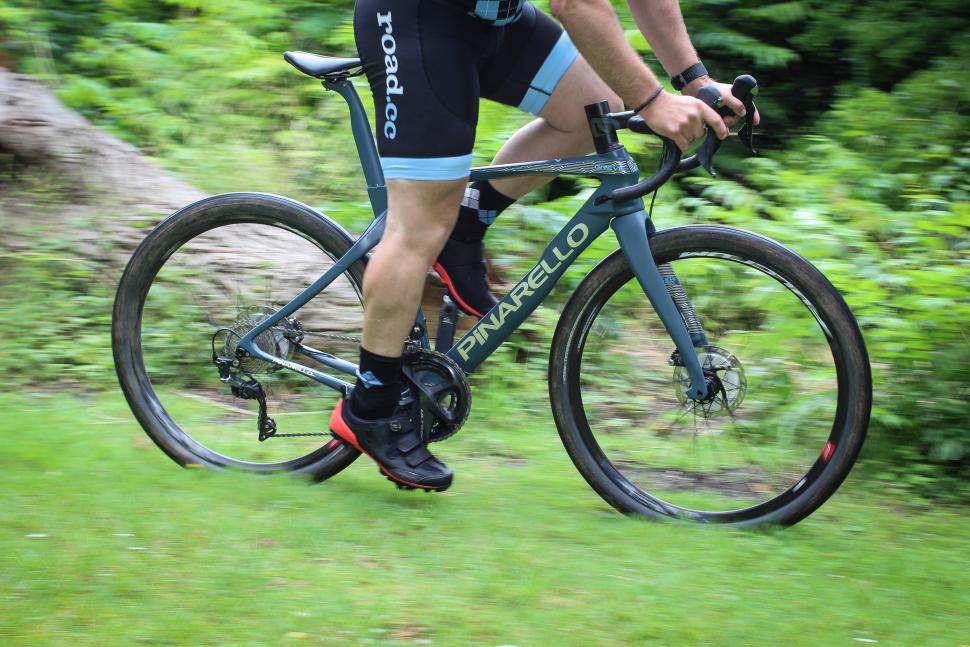
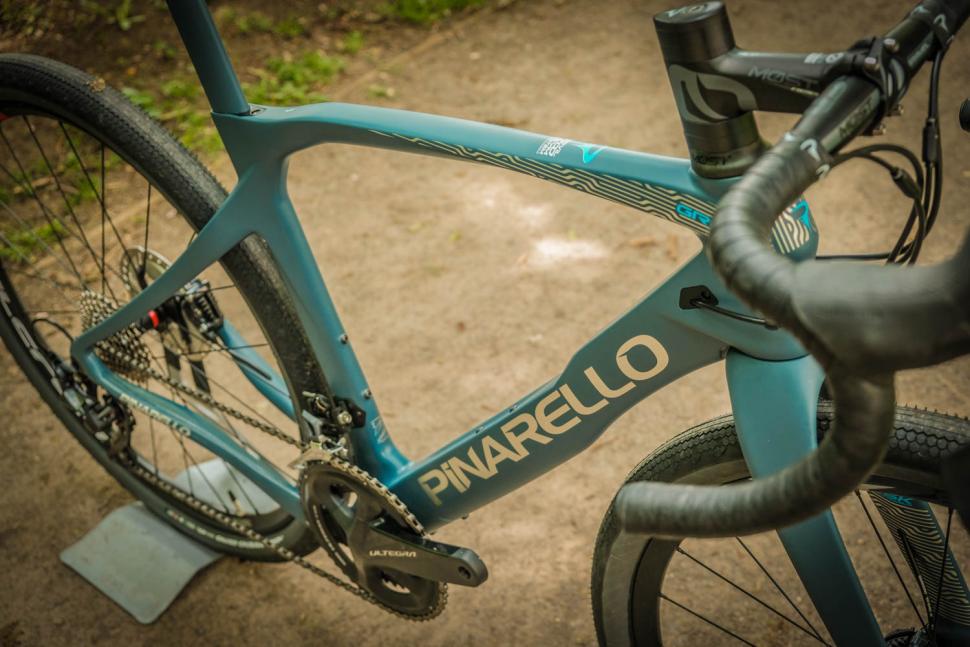

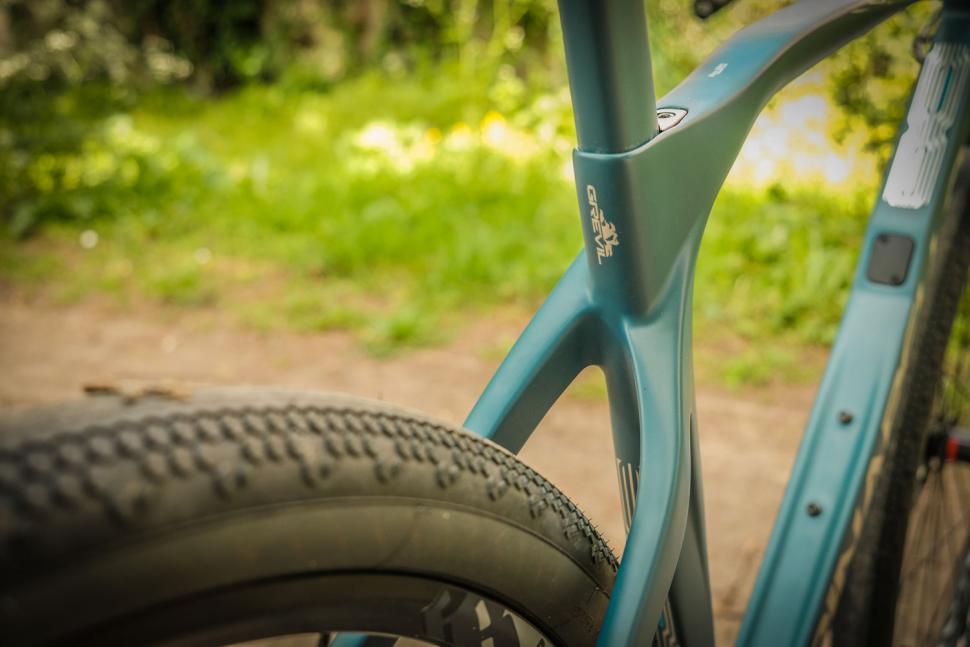



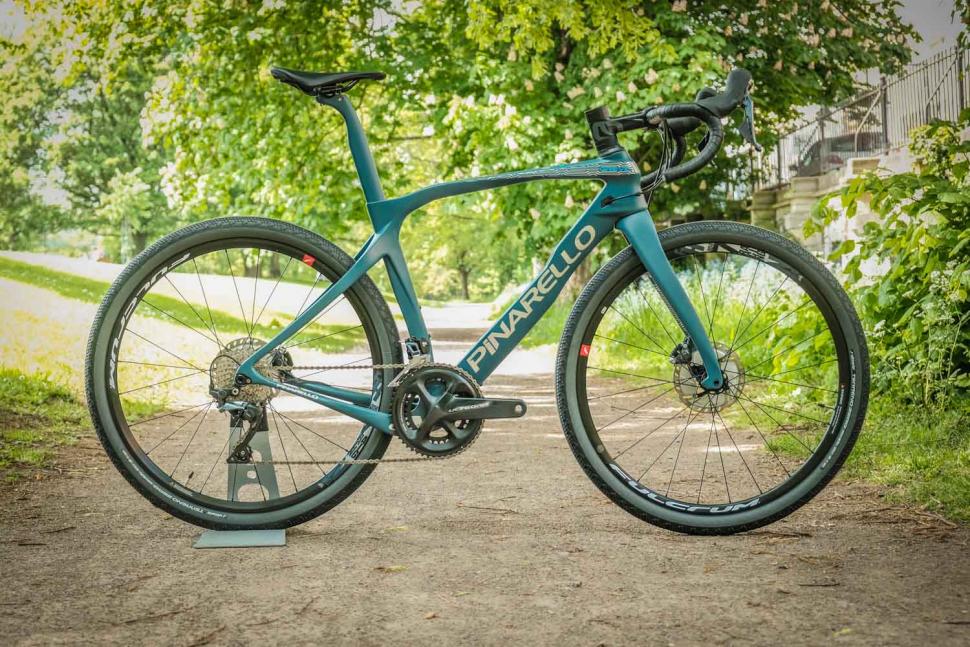




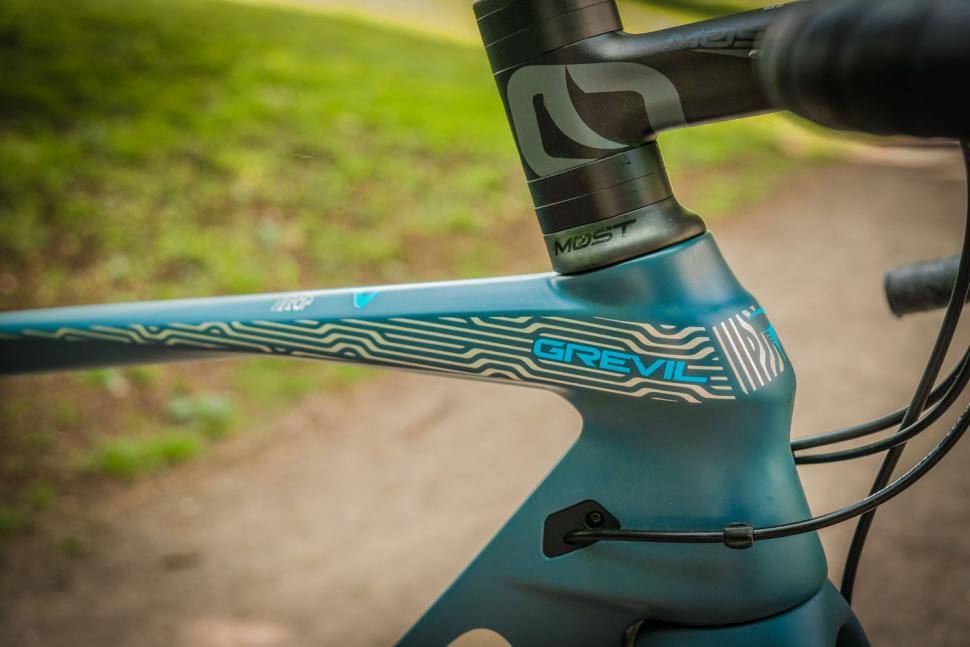

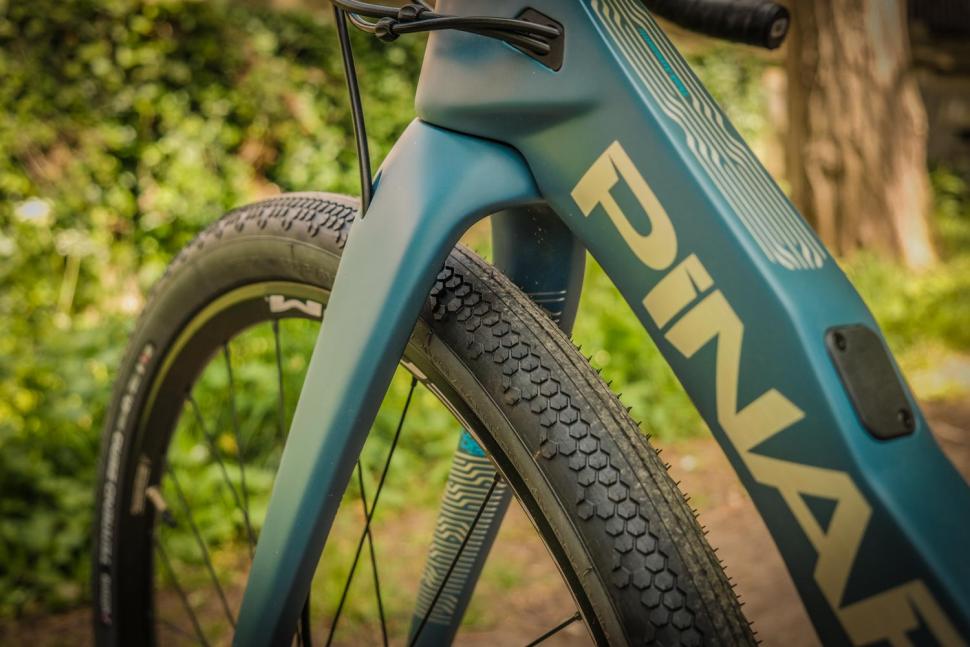

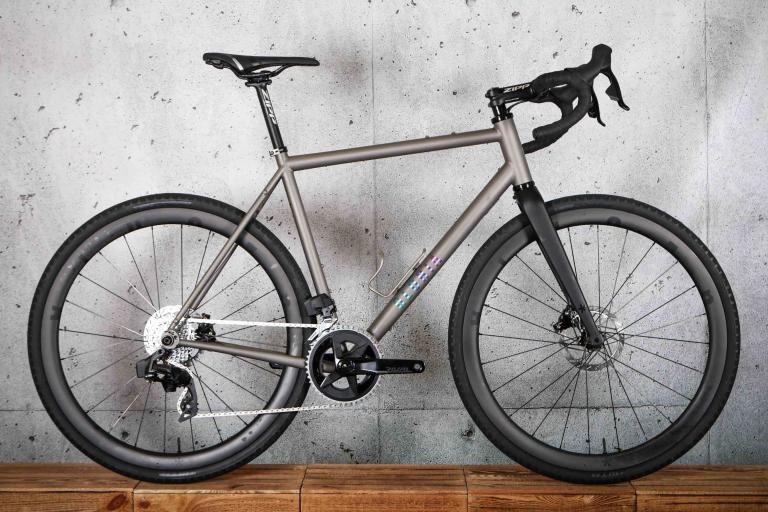
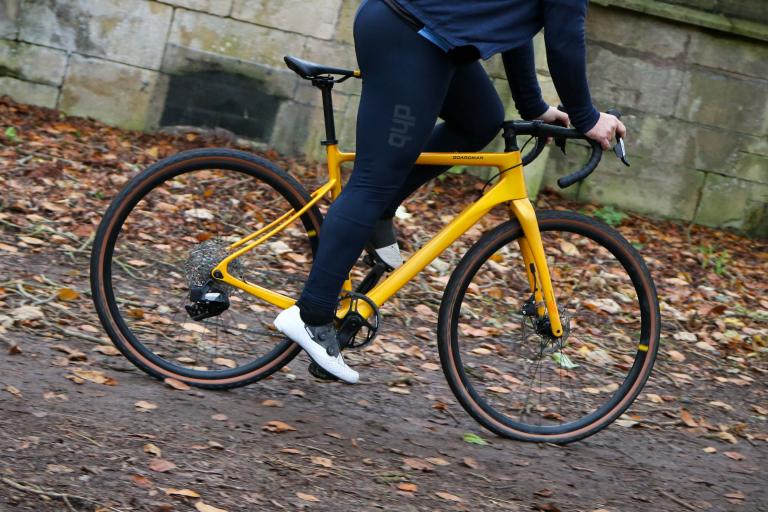

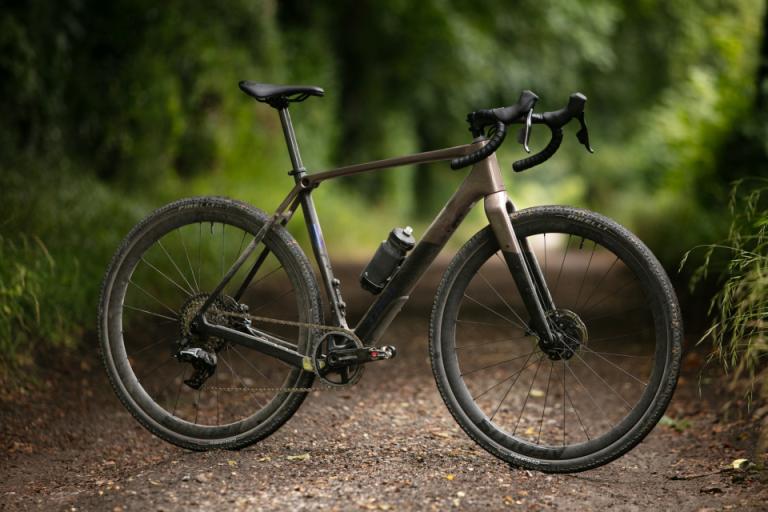
Add new comment
7 comments
If I wanted an aggressive, unforgiving gravel racer for approximately this price I'd get myself a Scott addict 10 gravel and immediately shed 2 kilos. The article compares the Grevil is with the Grail SL 8SL(X) which I happen to own. Upgraded it with a carbon wheelset and ride 28 mm tyres, but I wouldn't put it on the racier end of the spectrum. .Looks are personal but it's not for me.
Looks a little like my Boardman ADV 9.0. Which is one very good bike for a 1/3 of price.
looks like it just came out of the washing machine and needs some
ironingcarboning.Slight tanget: why are all these gravel bikes muted browns/greens/greys? You can get cyclocross and MTBs in any crazy colour you want, but gravel bikes ... uniformally dull.
I know they're not in the same league, but I have a Mango Point AR for off road duties. The colour is called nuclear green, I think. It's not subtle.
I really like the look of this bike (price aside).. it just looks fun and I can't put my finger on why.
I agree, my guess is that it is the fat tires and fat'ish frame.